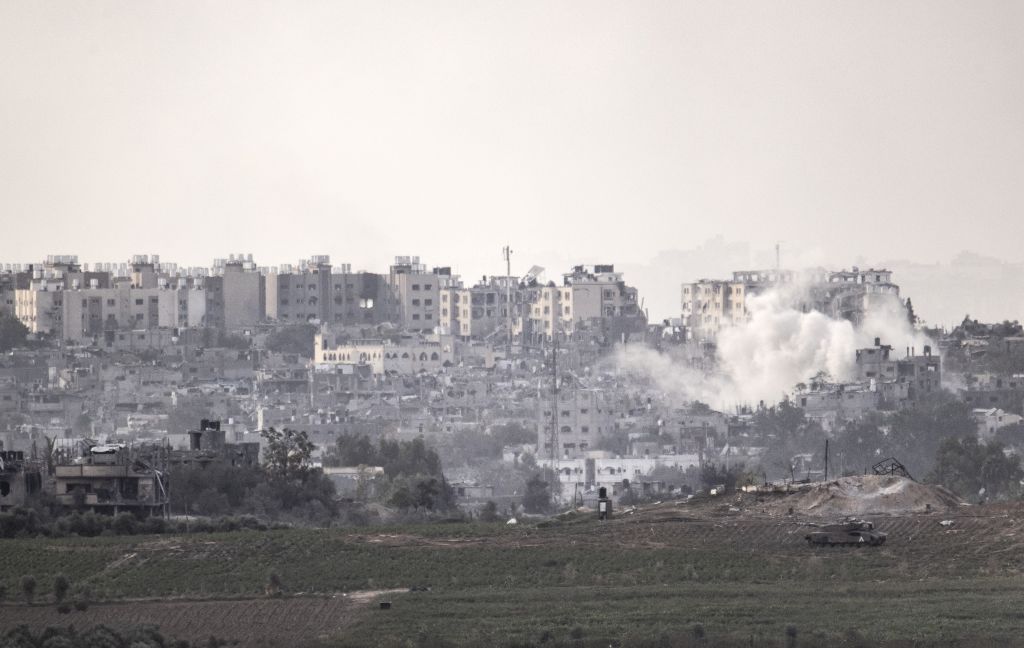Urban conflict is messy. It appears the Israelis are making at least an initial push into Gaza, and this is the terrain on which they are fighting. It is a textbook example of such combat, consisting almost exclusively of urban construction. Gaza is also densely populated and has a complex network of tunnels and other underground rooms and passages. The cost—to both Israel and Palestinians—of breaching such terrain could set off an unpredictable chain of regional events.
Urban terrain is a subset of what is referred to in military jargon as “close terrain”—a location in which the standoff advantages of a modern military are negated, in whole or part. Urban terrain is also the most challenging subset of close terrain as it is three-dimensional. Aside from someone who has climbed a tree, a Vietnam-like jungle, while definitely close terrain, is still a two-dimensional battlefield. But in a city, or a tunnel complex, it is very possible to be attacked from above and/or below.
A desert is more or less the polar opposite of close terrain. Here—as Saddam’s Iraqi Army found in 1991—airpower can destroy formations in depth, while the extended ranges of Western weapon systems—tanks, fighting vehicles, guided missiles—can engage with the enemy before the enemy can effectively return fire. Modern militaries are optimized for open terrain, and it’s where they prefer to fight.
Close terrain eliminates this advantage because you can’t know you are in danger until an enemy is inside your close range. Therefore the enemy is always—in the words of the Vietnamese—“hugging the belt,” or getting and staying close enough that the advantages of a modern military are (mostly) negated. Airpower and artillery superiority do you no good when the enemy is just a few yards away.
When military forces encounter each other at close range, intangibles matter more. A 50-year-old local resident with a World War II-era submachine gun, provided that he is patient and disciplined and also familiar with the buildings and/or tunnel systems, may have an advantage in the close fight over a 20-year-old invading infantryman with all his 21st century “kit.”
The response of modern militaries is generally to use firepower, whether tank rounds, artillery, or airstrikes, to the maximum extent possible. The firepower then does two things. First, it kills or wounds said 50-year-old locals carrying submachine guns, though with significant civilian collateral damage. But second, it changes the terrain. Buildings and tunnels collapse and new rubble falls into place. This removes, in part, the “home field” advantage for the less advanced force, at least until it can learn the contours of the rearranged battlefield.
We have several examples of modern armies fighting on urban terrain in recent history. The U.S. Army fought high intensity battles in 2004 in Najaf and Fallujah, while the Israelis themselves made limited incursions into Gaza in 2014. But the most relevant recent battle may be the recapture of Mosul by Iraqi special forces, supported by Western artillery and airpower, in 2016-17. While numbers are contested, the best estimates are that a force of more than 100,000 (Iraqi army, Peshmerga, and Hashd—most of them isolating the city) engaged 3,000 to 5,000 ISIS fighters, with about 14,000 Iraqi special forces doing the bulk of the clearing work inside the city. Gaza is estimated to have 20,000-25,000 Hamas fighters, who will know the terrain better (they grew up there) and will have tighter trust bonds (they grew up together) than did their ISIS counterparts (who were mostly not from the city of Mosul). Meanwhile, the Israelis are (wisely) not telegraphing how large an invading force they would choose to deploy.
Of course, the Iraqi mission was to totally clear ISIS from the city so that it could be returned to control by the government. The Israelis may well have more limited goals in Gaza. Nonetheless, the precedent in terms of casualties should give pause. The following figures come from a source I most trust, an American with a privileged view of the conflict:
The heroism of the Iraqi soldiers who fought in Mosul cannot obscure the startling cost of liberation: some 8,200 dead Iraqi servicemen (a whopping 60% casualty rate among the elite CTS), an estimated 10,000 civilians killed (though likely much higher) of which 3,200 are thought to have perished in coalition airstrikes, and the destruction of 40,000 homes in west Mosul alone.
Like I said, urban conflict is messy. Full stop.
Further, these are the results you get by putting your cutting edge, elite forces into the fray. The Iraqi Counter-Terrorism Service (CTS, above) has still not fully recovered, more than six years later, from the losses it took during the fight. And the CTS was, at the time, a veteran, experienced, blooded force, having fought—and won—in urban battles such as Fallujah, Ramadi, and Tikrit.
This stands in contrast to the Israeli forces that will likely be doing the clearing. As my friend Andrew Exum has pointed out:
Israel has an excellent air force and elite special-operations units, but its conventional line units—made up mostly of conscripts—are neither particularly well trained nor well disciplined by American standards. … [T]oday Israel faces highly disciplined and motivated nonstate foes in southern Lebanon and the Palestinian territories, and its military does not seem to have a clear advantage over them at the unit level.
Close combat is demanding at the individual and small unit level, and (largely) neutralizes the benefits of a high-technology military. The only real preparation that can be accomplished is, as is currently happening, by using artillery and aerial fires to “soften” defenders. But, as pointed out above and as we are painfully learning (regardless of whose casualty count you believe), such a fires campaign—even one with an American focus, however imperfect, on preventing collateral damage—inevitably imposes a high cost on the civilian population that also characterizes the urban battlefield.
Therefore, while it is very possible that Israel could indeed push into Gaza, we should expect such a fight to be characterized by three things: high casualties among the Israeli infantry, high casualties among the civilian population, and a long, extended fight. The battle for Mosul lasted nine months and four days. Against a smaller defending force than should be expected in Gaza. With a much more experienced clearing force. And supported by Western artillery and airpower comparable to that of the Israelis. Should Israel be serious about maximalist goals, this fight will be measured not in days or weeks, but in months.
This brings up a number of relevant but incredibly terrifying questions. Can Israel, and the region, sustain a months-long campaign? What happens in local capitals? In the “Arab street”? In EU capitals? To the Israeli economy with its mobilized reservists? To Middle-East dependent oil supplies? Can Hezbollah remain out of the fray if the fight drags out? Can the U.S. remain on the sidelines if Hezbollah jumps in? Can Israel absorb extremely high per capita casualties? Will Western intelligence and police forces be able to detect and prevent likely terrorist attacks?
This pending fight, which promises to kill and wound large numbers of combatants and noncombatants alike, moves us rapidly into a world of incredible uncertainty. Each of the questions above is inherently unknowable. Taken in concert, the future world becomes incredibly amorphous—and note that the above mentions neither the Russia-Ukraine war, nor Chinese military provocations.
A serious Israeli incursion into Gaza will present Israel with a very wicked military problem, and the world with a host of downstream political consequences. One would hope that statesmen (and women) around the world are conferring to buffer against such, as Israel seriously considers its military options.






Please note that we at The Dispatch hold ourselves, our work, and our commenters to a higher standard than other places on the internet. We welcome comments that foster genuine debate or discussion—including comments critical of us or our work—but responses that include ad hominem attacks on fellow Dispatch members or are intended to stoke fear and anger may be moderated.
With your membership, you only have the ability to comment on The Morning Dispatch articles. Consider upgrading to join the conversation everywhere.